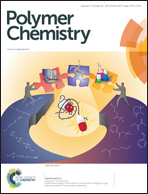Thiol–isocyanate click reaction in a Pickering emulsion: a rapid and efficient route to encapsulation of healing agents†
Abstract
An innovative, rapid and efficient route is developed to fabricate ene loaded microcapsules via a thiol–isocyanate click reaction based on a hydrolyzed poly(glycidyl methacrylate) (PGMA) particle stabilized oil-in-water Pickering emulsion. The whole process for the reaction only requires 10 min, opening up a new, time-saving and energy-efficient strategy. The oil droplets contain isophorone diisocyanate (IPDI), trimethylolpropane tris(3-mercaptopropionate) (TMMP) and 1,3,5-tri-2-propenyl-1,3,5-triazine-2,4,6 (1H, 3H, 5H)-trione (TTT), in which IPDI and TMMP are subsequently catalyzed by triethylamine (TEA) to produce a polythiourethane network, forming microcapsules. From scanning electron microscopy (SEM) and optical microscopy (OM), the resulting microcapsules are in good spherical shape and their outer surface is coated with a compact PGMA particle layer. The mean diameter of the TTT loaded microcapsules decreases from 238.8 to 110 μm with increasing the particle stabilizer concentration. Solid-state 13C NMR measurement proves that almost no side reactions exist in the base-catalyzed thiol–isocyanate reaction. Moreover, the core content (up to 67.8%) and the thickness of the shell wall (8–36 μm) can be adjusted by the feeding amount of core materials. These microcapsules with an outer PGMA layer disperse well and maintain their integrity in the epoxy coating, and no agglomeration is observed. Even though being encapsulated, the core ingredient maintains high reactivity as its raw version and exhibits favorable healing capability. Furthermore, besides TTT, the proposed method is versatile and applicable to the encapsulation of SR833S and diallyl phthalate.


 Please wait while we load your content...
Please wait while we load your content...